Functional Training Circuit You Can Do at Home
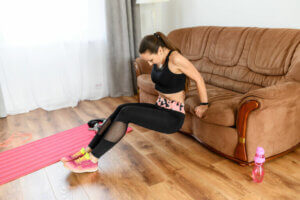
A functional training circuit is a great tool to stay in shape and work out at home. This workout method is characterized by exercises and movements that help the individual to carry out functional tasks.
These exercises will be of great help when preparing and working your muscles for your everyday activities. On top of that, they also help to improve your sports performance and reduce the risk of injury.
Another important characteristic of functional training is that most exercises only use your own bodyweight to create the required resistance. Therefore, you don’t have to worry about not having the necessary equipment to get a good training session.
In today’s article, we’ll show you a routine of eight functional exercises that you can do without leaving home, and without any extra equipment. Let’s get to it!
Example of a functional training circuit
Besides the physical benefits that we mentioned above, it’s also important to talk about the psychological factor involved in functional training. Even though you can do this type of workout from home, it still contributes to your mental well-being, as Miguel Morilla points out in one of his research papers.
Another advantage of functional training is that anyone can easily adapt it to their specific needs. The difficulty will depend on the intensity with which each individual performs the exercises.
For this training routine, we’re suggesting a circuit of eight exercises, one after the other. Repeat the circuit three times, with a three-minute break in between each set.
1. Burpees
Burpees will be the first exercise; you’ll have to perform ten repetitions. For this movement, it’s extremely important to pay attention to your form and technique. Not doing so could considerably increase the risk of injury.
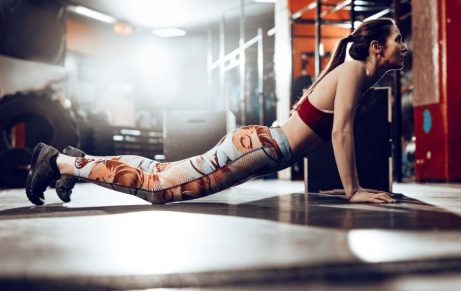
Begin by standing with your legs shoulder-width apart. Then, squat down and place your hands on the floor in front of you. Extend your legs back until you’re in a plank position.
Once you’re there, bring your chest close to the ground to do a push-up. Finally, bring your legs back in and jump up to go back to the starting position.
2. Arm curls
It’s important to mix aerobic exercises with strength training, and leg exercises with arm exercises. Push-ups are a great option for this. You’ll have to do 15 repetitions.
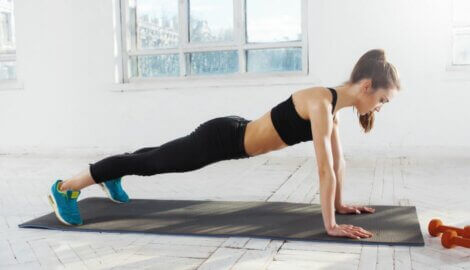
There are two alternatives: if it’s difficult for you to perform a push-up using only your hands and feet as support, you can bring down your knees as well. This will reduce the weight you’re working with and make the movement easier. The other option is to do a regular push-up, similar to the one in the image above.
3. Mountain climbers, the best addition to a functional training circuit
For this exercise, you’ll do 20 repetitions. This movement has a clear aerobic component while allowing you to work on your core and pectoral area at the same time.
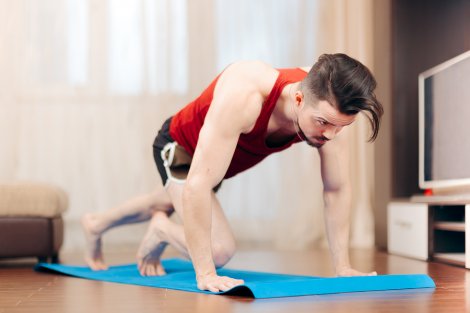
Start from a plank position, resting on your hands and the tips of your toes. Then, alternate bringing one knee and then the other towards your chest. It should look as if you were running.
4. Bench dips
This exercise will work another area of your arms, the triceps. You’ll be doing 15 reps of bench dips (as pictured in the cover image of this article). You can use a sofa, bed, or chair as a point of support. It’s important to have control over the movement, especially during the descent. Also, remember to keep your abs engaged throughout the whole exercise.
5. Abdominal plank
Core exercises should always be present in any routine. For this circuit, you’ll do an abdominal plank for 30 seconds.

To do this, lie face down using your forearms and the tips of your feet as support points; form a straight line all the way from head to feet. To avoid problems in the lumbar area, we advise you to perform a pelvic retroversion -bring the hips forward- in order to keep your abdomen engaged.
6. One leg deadlift
This is another lower body exercise. You’ll be performing ten to twelve repetitions with each leg. As we mentioned in the previous paragraphs, you don’t need any extra equipment. However, if you want to increase the difficulty, you can hold a bottle of water with each hand. It’s important to keep your abs active at all times.
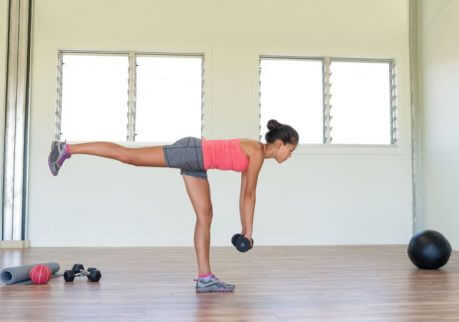
7. Dead bug exercise
For this movement, you’ll want to do ten repetitions with each leg and arm. This is a very important exercise to strengthen your core.
Start by lying down on your back, with your legs up and bent at a 90-degree angle in relation to the floor. Lift your arms and extend them upwards.
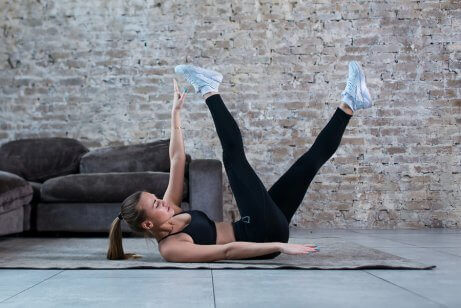
From this position, extend one leg and move the opposite arm towards the back. As in previous exercises, you must keep your core engaged at all times to avoid injuring your lumbar region (Akuthota & Nadler, 2004).
8. Squats
Finally, we can’t forget about squats; perform a total of 15 repetitions. If you want to increase the difficulty, hold some weight with your hands, such as a jug of water.
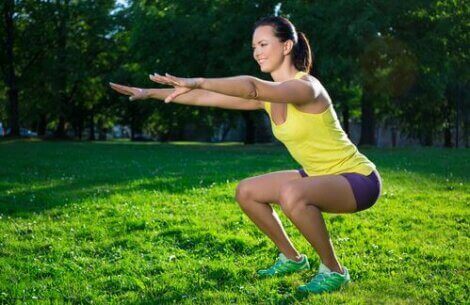
Once again, it’s essential to perform this exercise with the proper technique to avoid possible injuries. You also have to maintain a correct position in your back, keeping it as straight as possible. Avoid lifting your heels from the ground during the knee bend, which shouldn’t exceed 90 degrees with respect to the ground.
Do a functional training circuit at home
As you can see, doing a functional training circuit at home is something that anyone can do. And you don’t need any special equipment. It’s important to alternate exercises that involve the different body areas so that your training is more complete.
A functional training circuit is a great tool to stay in shape and work out at home. This workout method is characterized by exercises and movements that help the individual to carry out functional tasks.
These exercises will be of great help when preparing and working your muscles for your everyday activities. On top of that, they also help to improve your sports performance and reduce the risk of injury.
Another important characteristic of functional training is that most exercises only use your own bodyweight to create the required resistance. Therefore, you don’t have to worry about not having the necessary equipment to get a good training session.
In today’s article, we’ll show you a routine of eight functional exercises that you can do without leaving home, and without any extra equipment. Let’s get to it!
Example of a functional training circuit
Besides the physical benefits that we mentioned above, it’s also important to talk about the psychological factor involved in functional training. Even though you can do this type of workout from home, it still contributes to your mental well-being, as Miguel Morilla points out in one of his research papers.
Another advantage of functional training is that anyone can easily adapt it to their specific needs. The difficulty will depend on the intensity with which each individual performs the exercises.
For this training routine, we’re suggesting a circuit of eight exercises, one after the other. Repeat the circuit three times, with a three-minute break in between each set.
1. Burpees
Burpees will be the first exercise; you’ll have to perform ten repetitions. For this movement, it’s extremely important to pay attention to your form and technique. Not doing so could considerably increase the risk of injury.

Begin by standing with your legs shoulder-width apart. Then, squat down and place your hands on the floor in front of you. Extend your legs back until you’re in a plank position.
Once you’re there, bring your chest close to the ground to do a push-up. Finally, bring your legs back in and jump up to go back to the starting position.
2. Arm curls
It’s important to mix aerobic exercises with strength training, and leg exercises with arm exercises. Push-ups are a great option for this. You’ll have to do 15 repetitions.

There are two alternatives: if it’s difficult for you to perform a push-up using only your hands and feet as support, you can bring down your knees as well. This will reduce the weight you’re working with and make the movement easier. The other option is to do a regular push-up, similar to the one in the image above.
3. Mountain climbers, the best addition to a functional training circuit
For this exercise, you’ll do 20 repetitions. This movement has a clear aerobic component while allowing you to work on your core and pectoral area at the same time.

Start from a plank position, resting on your hands and the tips of your toes. Then, alternate bringing one knee and then the other towards your chest. It should look as if you were running.
4. Bench dips
This exercise will work another area of your arms, the triceps. You’ll be doing 15 reps of bench dips (as pictured in the cover image of this article). You can use a sofa, bed, or chair as a point of support. It’s important to have control over the movement, especially during the descent. Also, remember to keep your abs engaged throughout the whole exercise.
5. Abdominal plank
Core exercises should always be present in any routine. For this circuit, you’ll do an abdominal plank for 30 seconds.

To do this, lie face down using your forearms and the tips of your feet as support points; form a straight line all the way from head to feet. To avoid problems in the lumbar area, we advise you to perform a pelvic retroversion -bring the hips forward- in order to keep your abdomen engaged.
6. One leg deadlift
This is another lower body exercise. You’ll be performing ten to twelve repetitions with each leg. As we mentioned in the previous paragraphs, you don’t need any extra equipment. However, if you want to increase the difficulty, you can hold a bottle of water with each hand. It’s important to keep your abs active at all times.

7. Dead bug exercise
For this movement, you’ll want to do ten repetitions with each leg and arm. This is a very important exercise to strengthen your core.
Start by lying down on your back, with your legs up and bent at a 90-degree angle in relation to the floor. Lift your arms and extend them upwards.

From this position, extend one leg and move the opposite arm towards the back. As in previous exercises, you must keep your core engaged at all times to avoid injuring your lumbar region (Akuthota & Nadler, 2004).
8. Squats
Finally, we can’t forget about squats; perform a total of 15 repetitions. If you want to increase the difficulty, hold some weight with your hands, such as a jug of water.

Once again, it’s essential to perform this exercise with the proper technique to avoid possible injuries. You also have to maintain a correct position in your back, keeping it as straight as possible. Avoid lifting your heels from the ground during the knee bend, which shouldn’t exceed 90 degrees with respect to the ground.
Do a functional training circuit at home
As you can see, doing a functional training circuit at home is something that anyone can do. And you don’t need any special equipment. It’s important to alternate exercises that involve the different body areas so that your training is more complete.
All cited sources were thoroughly reviewed by our team to ensure their quality, reliability, currency, and validity. The bibliography of this article was considered reliable and of academic or scientific accuracy.
- Akuthota, V., & Nadler, S. (2004). Core strengthening. Archives of Physical Medicine and Rehabilitation, 85(S1), S86-S92.
- Colado JC, Chulvi I, y Heredia, JR (2008) Criterios para el diseño de los programas de
acondicionamiento muscular desde una perspectiva funcional. Ejercicio físico en salas de acondicionamiento muscular: bases científico-médicas para una práctica segura y saludable. Rodríguez PL, ed. Madrid: Panamericana. pp 154-16 - Morilla Cabezas, M. (2001). Beneficios psicológicos de la actividad física y el deporte.
This text is provided for informational purposes only and does not replace consultation with a professional. If in doubt, consult your specialist.








